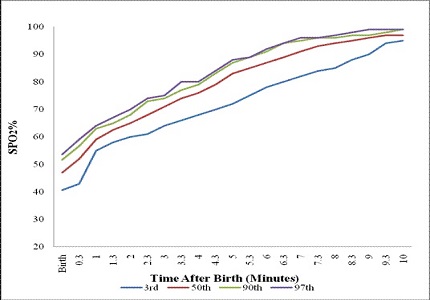Trends of Oxygen Saturation of Newborns after Birth from Northern India
Abstract
Aim: 1) To present the percentiles of oxygen saturation for newborns from Northern Indian set-up and to compare it with the reference range provided. 2) To analyze and compare the progression of oxygen saturation in term and preterm newborns.
Background: Even after knowing that preterm newborns may have different physiological requirements, they are being treated as similar entity as term newborns. No separate reference oxygen saturation ranges are available for them. Also little data is available about the percentiles of oxygen saturations for newborns in Indian set-up.
Material Methods: This was a Prospective Observational study done over a period of one year at a tertiary care hospital. 500 newborns with gestational age of 28-42 weeks, requiring routine care were enrolled. Oxygen saturation readings were recorded separately for term and preterm newborns till 10 minutes of life.
Results: SpO2 values of preterm newborns rises slowly as compared to term newborns. It took a mean time of 7.77±1.45 min (IQR of 6.3-9 minutes) for term newborns and 8.78 ± 0.97 min (IQR of 8.3-9.3 minutes) for preterm newborns to reach ≥ 85% SpO2. The 3rd, 10th, 25th, 50th, 75th, 90th and 97th percentiles of oxygen saturation have been calculated for both term and preterm newborns from birth till 10 minutes of life.
Conclusion: Preterm newborns should be treated as separate entity from term newborns to keep them safe from hazards of oxygen toxicity. This study provides the reference percentiles of oxygen saturation for term and preterm newborns from Northern India separately.
Downloads
References
2. Johnson K, Scott SD, Fraser KD. Oxygen use for preterm infants: factors that may influence clinical decisions surrounding oxygen titration. Adv Neonatal Care. 2011 Feb;11(1):8-14; quiz 15-6. doi: 10.1097/ANC.0b013e318206d0c0. [PubMed]
3. Perlman JM, Wyllie J, Kattwinkel J, Atkins DL, Chameides L, Goldsmith JP et al. Neonatal Resuscitation: 2010 International Consensus on Cardiopulmonary Resuscitation and Emergency cardiovascular Care Science with Treatment recommendations. Pediatrics; 126(5): 1319-1344.
4. Kattwinkel J, Perlman JM, Aziz K, Colby C, Fairchild K, Gallagher J, Hazinski MF et al. Part 15:neonatal resuscitation:2010 American Heart association Guidelines for Cardiopulmonary Resuscitation and Emergency Cardiovascular Care. Circulation.2010; 122 (18 Suppl 3): 909-919. [PubMed]
5. Tin W, Gupta S. Optimum oxygen therapy in preterm babies. Arch Dis Child Fetal Neonatal Ed. 2007 Mar;92(2):F143-7. [PubMed]
6. Ballard JL, Novak KK, Driver M. A simplified score for assessment of fetal maturation of newly born infants. J Pediatr. 1979 Nov;95(5 Pt 1):769-74. [PubMed]
7. Dawson JA, Kamlin CO, Vento M, Wong C, Cole TJ, Donath SM, Davis PG, Morley CJ. Defining the reference range for oxygen saturation for infants after birth. Pediatrics. 2010 Jun;125(6):e1340-7. doi: 10.1542/peds.2009-1510. Epub 2010 May 3. [PubMed]
8. Tiwari S, Tiwari S, Nangia S, Saili A. Oxygen saturation profile in healthy term neonates in the immediate post natal period. Int J Clin Pediatr. 2013: 2(1): 19-23.
9. O'Donnell CP, Kamlin CO, Davis PG, Morley CJ. Obtaining pulse oximetry data in neonates: a randomised crossover study of sensor application techniques. Arch Dis Child Fetal Neonatal Ed. 2005 Jan;90(1):F84-5.
10. Johnson K, Scott SD, Fraser KD. Oxygen use for preterm infants: factors that may influence clinical decisions surrounding oxygen titration. Adv Neonatal Care. 2011 Feb;11(1):8-14; quiz 15-6. doi: 10.1097/ANC.0b013e318206d0c0.
11. Evans NJ, Archer LN. Postnatal circulatory adaptation in healthy term and preterm neonates. Arch Dis Child. 1990 Jan;65(1 Spec No):24-6. [PubMed]
12. Nuntnarumit P, Rojnueangnit K, Tangnoo A. Oxygen saturation trends in preterm infants during the first 15 min after birth. J Perinatol. 2010 Jun;30(6):399-402. doi: 10.1038/jp.2009.178. Epub 2009 Nov 5.
13. Shah PS, Hakak H, Mohamed A, Shah J, Young J, Kelly E. Oxygen saturation profile in late-preterm and term infants: a prospective cohort study. J Perinatol. 2014 Dec;34(12):917-20. doi: 10.1038/jp.2014.107. Epub 2014 Jun .
14. Altuncu E, Ozek E, Bilgen H, Topuzoglu A, Kavuncuoglu S. Percentiles of oxygen saturations in healthy term newborns in the first minutes of life. Eur J Pediatr. 2008 Jun;167(6):687-8. Epub 2007 Jul 20. [PubMed]
15. Rabi Y, Yee W, Chen SY, Singhal N. Oxygen saturation trends immediately after birth. J Pediatr. 2006 May;148(5):590-4. [PubMed]

Copyright (c) 2016 Author (s). Published by Siddharth Health Research and Social Welfare Society

This work is licensed under a Creative Commons Attribution 4.0 International License.


 OAI - Open Archives Initiative
OAI - Open Archives Initiative


